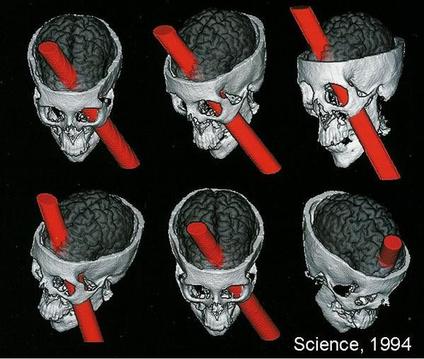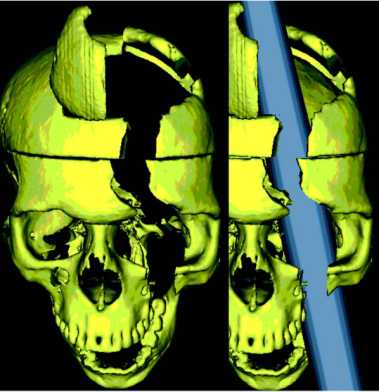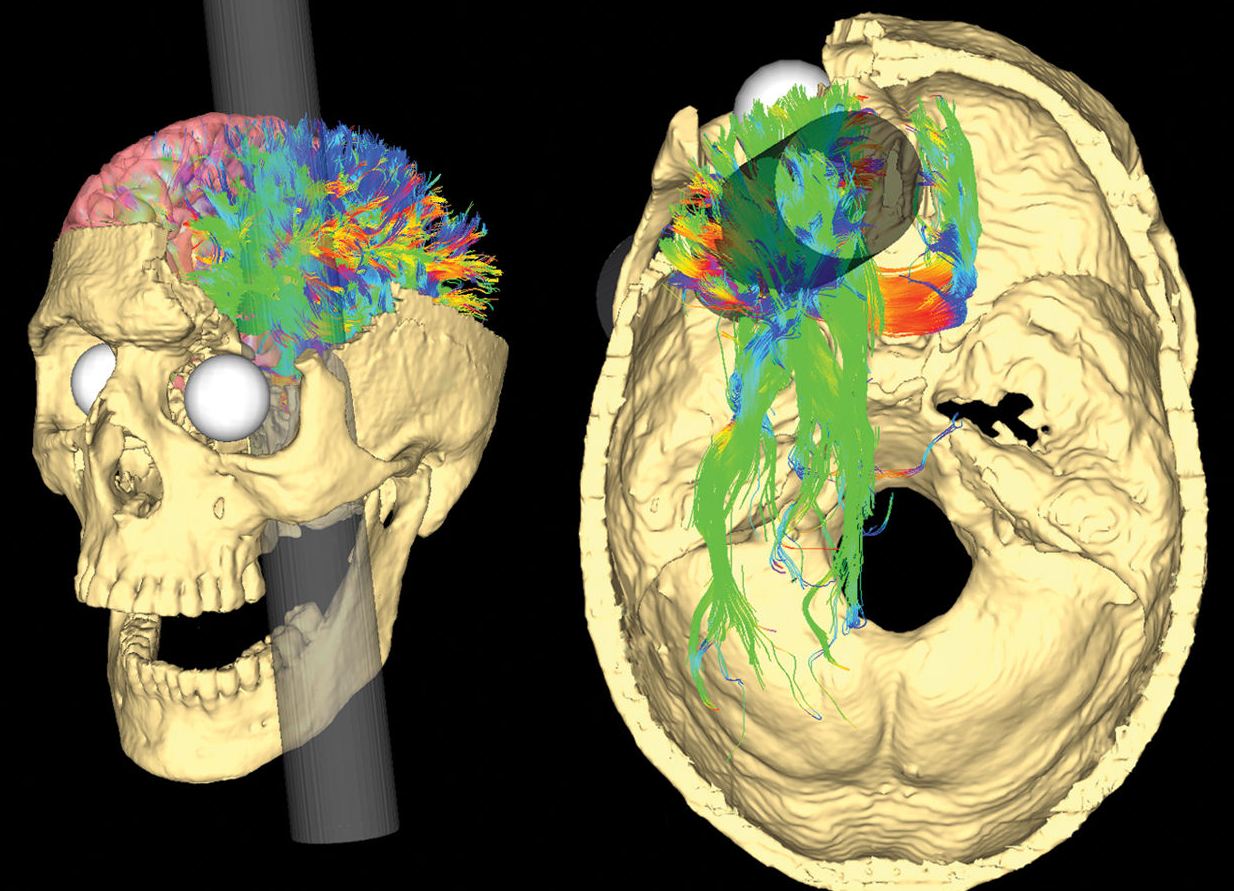Key Takeaways
- The case of Phineas Gage has been of huge interest in the field of psychology and is a largely speculated phenomenon.
- Gage suffered a severe brain injury from an iron rod penetrating his skull, which he miraculously survived.
- After the accident, Gage’s personality was said to have changed as a result of the damage to the frontal lobe of his brain.
- The frontal lobes are the seat of the neural networks that determine our personalities – problem-solving, spontaneity, memory, language, initiation, directed movement, judgment, impulse control, and social and sexual behavior.
- Gage’s case is famous in the field as it shows the resilience of the human brain and illustrates how certain areas of the brain have different functions and contribute to our personality.
What happened to Phineas Gage?
Phineas Gage was an American railroad construction foreman born in 1823.
On September 13th, 1848, when Gage was 25 years old, he was working in Cavendish in Vermont, leading a crew that was preparing the Rutland and Burlington Railroad by blasting rocks to make a roadbed.
This was done by using an iron tamping rod to pack the explosive powder into a hole. Whilst Gage was doing this, however, the powder detonated, and the tamping iron he was using launched from the hole and entered the left side of Gage’s face from the bottom up.
The iron rod (which was 43 inches long and 1.24 inches in diameter) penetrated Gage’s left cheek, traveling behind his left eye, entered through his left side brain, and exited his skull, landing 80 feet away.
After the incident, Gage was thrown onto his back from the force of the iron rod and had some brief convulsions of the arms and legs. Within a few minutes, however, Gage was able to get himself up, speak, and walk with small assistance to a nearby cart so he could travel into town.
A physician called Dr Edward H. Williams attended to Gage and reported that he could see ‘the pulsations of the brain being very distinct. The top of the head appeared somewhat like an inverted funnel.
Williams claimed that Gage was recounting his injuries to bystanders, and he did not initially believe the story, thinking that Gage was ‘deceived.’ Apparently, Gage had greeted Williams by angling his head at him and saying, ‘Here’s business enough for you.’
Williams recalled that Gage vomited, which led to about a teacupful of his brain falling upon the floor from the hole at the top of his skull.
What happened after the accident?
Dr. John Martyn Harlow took over the case of Gage soon after. Harlow (1848) reported that Gage was fully conscious and recognized Harlow at once but was tired from the bleeding.
In the next couple of days, Harlow observed that Gage spoke with some difficulty but could name his friends, and the bleeding ceased. Gage then spent September 23rd to October 3rd in a semi-comatose state but then was able to take steps out of bed by October 7th.
By October 11th, Harlow claimed Gage’s intellectual functioning began to improve. He recognized how much time had passed since the accident and could describe the accident clearly.
Four years after his injury, Gage moved to Chile and worked taking care of horses and being a stagecoach driver. In 1860, he moved to San Francisco, California, where his mother and sister lived, and was suffering from an illness of which Harlow did not know the nature.
How did Phineas Gage die?
On May 21st, 1861, twelve years after his accident, Gage died after having a series of repeated epileptic convulsions.
Seven years after Gage’s death, his body was unearthed, and his skull and the iron rod were given to Harlow and to this day, both are on display at the Harvard School of Medicine.
How did Phineas Gage’s personality change?
From Harlow’s written account, Gage was considered to be fully recovered and felt fit enough to reapply for his previous role as a foreman.
However, his contractors, who had regarded Gage as ‘efficient and capable’ before the accident, could no longer offer him work due to considerable changes in Gage’s personality. Marlow (1868) described him as follows:
“The equilibrium or balance, so to speak, between his intellectual faculties and animal propensities, seems to have been destroyed.
He is fitful, irreverent, indulging at times in the grossest profanity (which was not previously his custom), manifesting but little deference for his fellows, impatient of restraint or advice when it conflicts with his desires, at times pertinaciously obstinate, yet capricious and vacillating, devising many plans of future operations, which are no sooner arranged than they are abandoned in turn for others appearing more feasible.
A child in his intellectual capacity and manifestations, he has the animal passions of a strong man.”
“Previous to his injury, though untrained in the schools, he possessed a well-balanced mind, and was looked upon by those who knew him as a shrewd, smart business man, very energetic and persistent in executing all his plans of operation.
In this regard his mind was radically changed, so decidedly that his friends and acquaintances said he was ‘no longer Gage.”
Through Harlow’s reports, it can be suggested that Gage’s personality changed due to the accident he endured.
The accounts imply that the injury led to a loss of social inhibition, meaning that Gage would behave in ways that were considered inappropriate.
Damage to the brain
When Gage died in 1861, no autopsies were performed until his skull was later recovered by Harlow years later. The brain damage which caused the significant personality changes was presumed to have involved the left frontal region of the brain.
It was not until 1994 that complex computer-based methods to examine brain damage could be used to investigate whether other areas of the brain were affected.

Damasio et al. (1994) used measurements from Gage’s skull and neuroimaging techniques to determine the exact placement of the entry and exit point of the iron rod on a replica model (see Fig. 1).
They found that the damage caused by the rod involved both the left and right prefrontal cortices.
The left and right cortices are responsible for emotional processing and rational decision-making; therefore, it can be assumed that Gage had deficits in these areas.

A later study by Ratiu et al. (2004) also investigated Gage’s injury and the location of where the iron rod entered and exited the head. They used Gage’s actual skull rather than a model of it, as Damasio et al. (1994) had used.
Ratiu et al. (2004) generated three-dimensional reconstructions of the skull using computed tomography scans (CAT) and found that the extent of the brain injury was limited to the left frontal lobe only and did not extend to the right lobe (see Fig. 2).

More recently, Van Horn et al. (2012) used a CAT scan of Gage’s skull as well as magnetic resonance imaging (MRI) data obtained from male participants of a similar age to Gage at the time (aged 25-36).
Their results supported Ratiu et al. (2004) in that they always concluded that the rod only damaged the left lobe and not the right.
Van Horn, however, went a step further in their research and investigated the potential levels of white and grey matter damaged due to Gage’s injury. White matter is deep in the brain and provides vital connections around the brain, essential to normal motor and sensory function.
Grey matter in the brain is essential to many areas of higher learning, including attention, memory, and thought.
The research by Van Horn proposed that Gage lost about 11% of his white matter and about 4% of his grey matter. White matter has the ability to regenerate, so this could explain why Gage recovered as well as he did.
Van Horn et al. (2012) in their study compared Gage’s white matter damage to the damage that is caused by neurogenerative diseases such as Alzheimer’s.
This is supported by other studies that have found that changes in white matter is significantly associated with Alzheimer’s disease (Nasrabady, Rizvi, Goldman & Brickman, 2018; Kao, Chou, Chen & Yang, 2019).
It could be suggested that Gage’s apparent change in personality could have been the result of an early onset of Alzheimer’s.
However, as Dr. Harlow, who examined Gage, only reported on Gage’s behaviors shortly after his accident, rather than months or years later when Alzheimer’s symptoms may have emerged, we cannot be certain whether Gage actually had this condition.
Conclusion
All studies investigating the brain damage suffered by Gage is essentially all speculation as we cannot know for certain the extent of the accident’s effects. We know that some brain tissue got destroyed, but any infections Gage may have suffered after the accident may have further destroyed more brain tissue.
We also cannot determine the exact location where the iron rod entered Gage’s skull to the millimeter. As brain structure varies from person to person, researchers cannot ever know for certain what areas of Gage’s brain were destroyed.
The influence of Phineas Gage
Gage’s case is important in the field of neuroscience. The reported changes in his behavior post-accident are strong evidence for the localization of brain function, meaning that specific areas of the brain are associated with certain functions.
Neuroscientists have a better understanding today of the function of the frontal cortex. They understand that the frontal cortex is associated with functions of language, decision-making, intelligence, and reasoning. Gage’s case became one of the first pieces of evidence suggesting that the frontal lobe was directly involved in personality.
It was believed that brain lesions caused permanent deficits in a person. However, Gage was proven to have recovered remarkably and lived a mostly normal life despite his injury. It was even suggested by a psychologist called Malcolm Macmillan that Gage may have relearned lost skills.
People with damage to their frontal lobes tend to have trouble completing tasks, get easily distracted, and have trouble planning. Despite this damage to his frontal lobe, Gage was reported to have worked as a coach driver which would have involved Gage being focused and having a routine, as well as knowing his routes and multitasking.
Macmillan (2002), therefore, suggests that Gage’s damage to the frontal lobe could have somewhat repaired itself and recovered lost functions. The ability of the brain to change in this way is called brain plasticity.
Over time, Gage’s story has been retold, and this has sometimes led to a lot of exaggeration as to the personality changes of Gage. Some popular reports described him as a hard-working, kind man prior to the accident and then described him as an aggressive, dishonest, and drunk man who could not hold down a job and died pennilessly.
Gage’s story seemed to take on a life of its own, and some even went as far as to say that Gage became a psychopath after his accident, without any facts behind this.
From the actual reports from the people in contact with Gage at the time, it appears that his personality change was nowhere near as extreme and that Gage was far more functional than some reports would have us believe (Macmillan, 2002).
References
Damasio, H., Grabowski, T., Frank, R., Galaburda, A. M., & Damasio, A. R. (1994). The return of Phineas Gage: clues about the brain from the skull of a famous patient. Science, 264 (5162), 1102-1105.
Harlow J. M. (1848). Passage of an iron rod through the head. Boston Medical and Surgical Journal, 39, 389–393.
Harlow, J. M. (1868). Recovery from the Passage of an Iron Bar through the Head. Publications of the Massachusetts Medical Society. 2 (3), 327-347.
Kao, Y. H., Chou, M. C., Chen, C. H., & Yang, Y. H. (2019). White matter changes in patients with Alzheimer’s disease and associated factors. Journal of clinical medicine, 8 (2), 167.
Macmillan, M. (2002). An odd kind of fame: Stories of Phineas Gage. MIT Press.
Nasrabady, S. E., Rizvi, B., Goldman, J. E., & Brickman, A. M. (2018). White matter changes in Alzheimer’s disease: a focus on myelin and oligodendrocytes .
Acta neuropathologica communications, 6
(1), 1-10.
Ratiu, P., Talos, I. F., Haker, S., Lieberman, D., & Everett, P. (2004). The tale of Phineas Gage, digitally remastered. Journal of neurotrauma, 21 (5), 637-643.
Van Horn, J. D., Irimia, A., Torgerson, C. M., Chambers, M. C., Kikinis, R., & Toga, A. W. (2012). Mapping connectivity damage in the case of Phineas Gage.
PloS one, 7(5), e37454.
Further Reading
If a person suffers from a traumatic brain injury in the prefrontal cortex, similar to that of Phineas Gage, what changes might occur?
A traumatic brain injury to the prefrontal cortex could result in significant changes in personality, emotional regulation, and executive function. This region is vital for impulse control, decision-making, and moderating social behavior.
A person may exhibit increased impulsivity, poor judgment, and reduced ability to plan or organize. Emotional volatility and difficulty in interpersonal relationships may also occur.
Just like the case of Phineas Gage, who became more impulsive and less dependable, the injury could dramatically alter one’s character and abilities.

